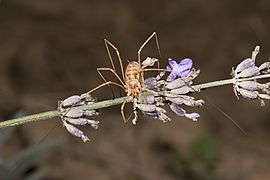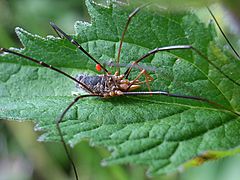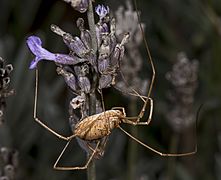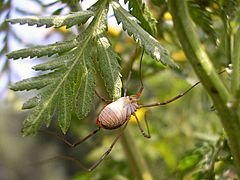Phalangium opilio facts for kids
Quick facts for kids Phalangium opilio |
|
|---|---|
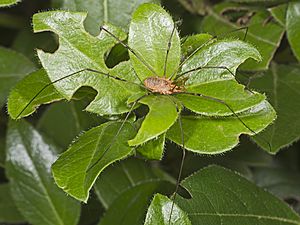 |
|
| Male Phalangium opilio | |
| Scientific classification | |
| Kingdom: | |
| Phylum: | |
| Class: | |
| Order: | |
| Family: |
Phalangiidae
|
| Genus: |
Phalangium
|
| Species: |
P. opilio
|
| Binomial name | |
| Phalangium opilio |
|
Phalangium opilio is a very common type of harvestman. It is found all over the world. This creature originally lived in Europe and much of Asia. Now, it has also spread to North America, North Africa, and New Zealand.
You can find Phalangium opilio in many different places. These include meadows, forests, and even places built by people. They live in gardens, farm fields, and along hedgerows. You might also spot them on lawns, in quarries, or on walls and bridges. Phalangium opilio helps farmers by eating the eggs of pests like the corn earworm (Helicoverpa zea). This makes them a natural way to control pests. Like most harvestmen, this species is active at night, which means it is nocturnal.
What Does Phalangium opilio Look Like?
Female Phalangium opilio are usually between 6 and 9 millimeters (about 0.2 to 0.35 inches) long. Males are a bit smaller, measuring 4 to 7 millimeters (about 0.15 to 0.27 inches). However, male harvestmen have much longer legs. The second leg of a male can be about 54 millimeters (about 2.1 inches) long. For females, this leg is usually around 38 millimeters (about 1.5 inches).
Both males and females have similar colors and patterns. Their bodies often have a dark, three-lobed shape that looks like a saddle. This saddle usually has small spots or lines down the middle. It can be tricky to tell Phalangium opilio apart from a similar species called Mitopus morio. But P. opilio has two small, pale, tooth-like bumps called "denticles." These are found just below the front edge of its head shield, known as the carapace. Male Phalangium opilio are special because they have long, forward-pointing "horns" on the second part of their mouthparts, called chelicerae.
Images for kids


